Ukraine has an extensive railway system to the Russian gauge of 5 feet and, although Ukraine has been a sovereign state since 1991, the railway infrastructure and rolling stock was principally provided by Russia during the Tsarist and Soviet eras.
My post Ukraine 2005 briefly describes my trip to Ukraine in 2005 to drive Russian-built steam locomotives. After a long interval, I added more detail in a series of posts starting with Driving Steam in Ukraine (Part 1). The last day of our driving in Kolomiya and our journey by overnight train back to Kiev is described here.
Events of Friday, 28th October 2005
On our arrival in Kiev, the trip organisers (East Europe Railtours Limited in the U.K. and Dzherelo SPK in Ukraine) had arranged visits to two Railway Workshops.
Kiev Railway Works (Passenger)
This works dealt with heavy maintenance to passenger locomotives. The entrance to the works was near the south east end of Kiev main station. We stopped to admire the only surviving 'FDp20' steam locomotive, displayed on a very elaborate welded steel plinth, suggesting a girder bridge. There's a little more about this locomotive class in Loco-profile 3: Russian 'FDp20' class 2-8-4.
 The remaining FDp class 'plinthed' at the entrance to Kiev Locomotive Works (Passenger).
The remaining FDp class 'plinthed' at the entrance to Kiev Locomotive Works (Passenger).
Before entering the works, we watched the comings and goings on the main line and looked at the outside of the 8-road locomotive roundhouse.
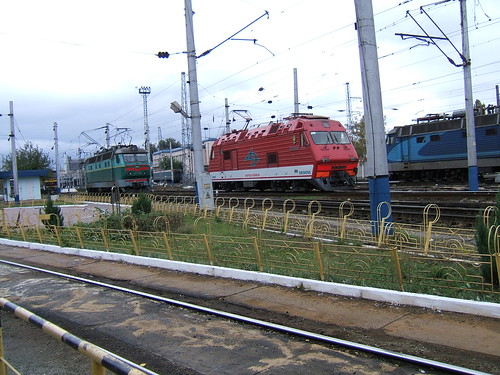 A variety of electric traction outside Kiev Main Station. Note the decorative fencing and the shrubs.
A variety of electric traction outside Kiev Main Station. Note the decorative fencing and the shrubs.
 The depot roundhouse. Note the overhead catenary for each road.
The depot roundhouse. Note the overhead catenary for each road.
In the first works building there were various types of electric locomotive, including an elderly 'Skoda'.
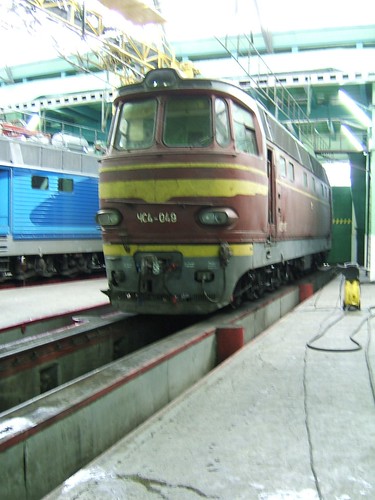
An elderly Skoda ChS4 Co-Co 25 kV a.c. electric locomotive, number 049. These were built between 1966 and 1972 and featured a fibreglass body but were being rebuilt to extend their life.
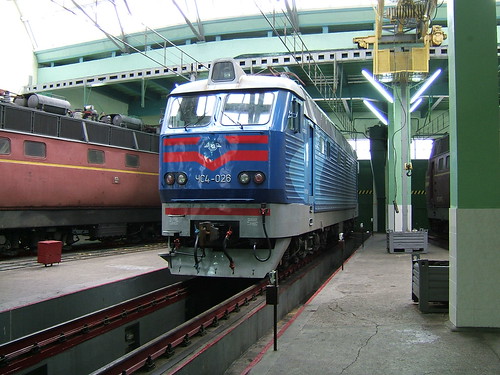 A rebuilt Skoda ChS4 Co-Co 25 kV a.c. locomotive, number 026.
A rebuilt Skoda ChS4 Co-Co 25 kV a.c. locomotive, number 026.
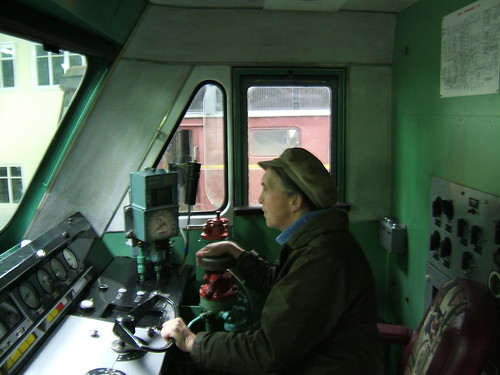 Jan in the Driving cab of rebuilt Skoda ChS4 Co-Co electric locomotive, number 026.
Jan in the Driving cab of rebuilt Skoda ChS4 Co-Co electric locomotive, number 026.
A separate 'shop' dealt with repairs to the driver's air brake application valve. This was a lofty room with large curtained windows, a domestic wall clock, rather dated light fittings incorporating fluorescent tubes and a potted plant.

The Brake Valve Shop.
We walked through a corridor (where a large artwork had been placed to encourage workers) to look at the shop where Speed Recorders were refurbished. An adjacent shop dealt with the re-machining of the discs for brake application valves (to keep them air-tight). We then passed through the erecting shop for electric locomotives, provided with an overhead travelling crane, inspection pits and high-level access platforms to get to roof-mounted equipment.
 The Erecting Shop.
The Erecting Shop.
One pit was provided with a wheel lathe for re-profiling tyres whilst the wheelset was still mounted on the bogie. There were various parts littered around - complete motors, a 'Scissors' pantograph, motor armatures awaiting attention. Nearby, an almost-deserted machine shop had a veteran selection of large lathes and machine tools. Another shop was re-furbishing the large Blowers used on electric locomotives. There were at least three men intently working away here. I noticed a small electric hoist had been slung from one of the steel roof beams, to ease the handling of the bulky fan assemblies. In another long corridor, there was another large artwork - this one of a smiling, athletic young woman. As we left the Workshops, we passed the Conservatory - in the U.S.S.R., large factories commonly had Conservatories so that workers were able to enjoy Nature even in harsh weather.
 The Conservatory.
The Conservatory.
Finally, we passed a suitably-heroic mosaic near the entrance to the Works.
 The mosaic near the entrance to the Locomotive Works.
The mosaic near the entrance to the Locomotive Works.
The rather run-down appearance of the buildings and the various inspirational artworks certainly suggested how I imagine the U.S.S.R. was after the gruelling years of the second world war. The Works have clearly lacked recent investment, but it was impossible not to be impressed by the skills of the people working there.
Kiev Railway Works (Freight)
A coach took us to the second works, which handles heavy maintenance of freight locomotives. It took almost an hour to reach the site - traffic in the city was heavy and our destination was on the outskirts of Kiev. I think the site served as a running depot for both diesel and electric traction, for in the extensive yard, we found both electric and diesel locomotives. In the Repair Shops, we only saw diesel locomotives under repair. A hand-painted plan of the yard was on display.
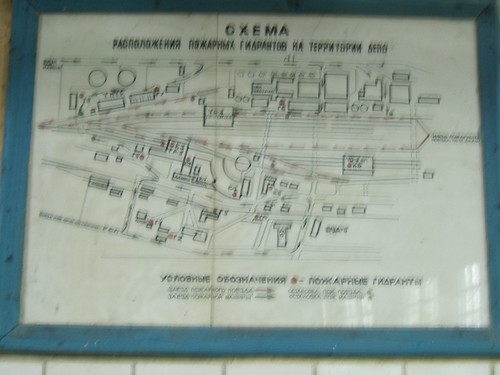 Plan of the Yard.
Plan of the Yard.
In the yard, there was a Type VL80 2-section Bo-Bo 25 kV a.c. electric locomotive, number VL80s288. The 's' isn't clear in the picture but the cab side also carries the later number 12505764 in the Russian 1984 numbering system (briefly explained here) which appears to confirm the sub-type as 's', meaning that two 2-section locomotives could be connected in multiple. A second VL80 (VL80t1324) was of the 't' sub-type with rheostatic braking.
 View of the yard with a Type VL80 2-section Bo-Bo 25 kV a.c. electric locomotive. The two tall towers in the background appear to be built using pre-cast concrete sections.
View of the yard with a Type VL80 2-section Bo-Bo 25 kV a.c. electric locomotive. The two tall towers in the background appear to be built using pre-cast concrete sections.
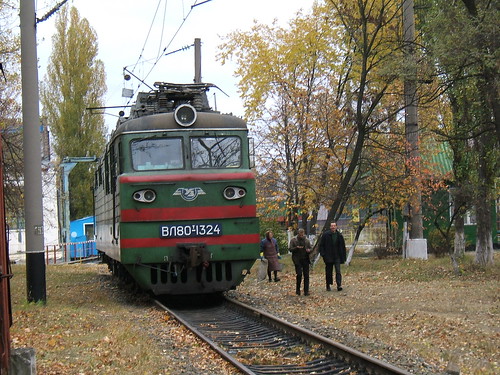 Another VL80 in the yard (VL80t1324).
Another VL80 in the yard (VL80t1324).
Diesel traction was represented in the yard by a 2-section Co-Co diesel electric 2TE116-1365 and a 750mm gauge diesel electric locomotive (TU2-165) loaded on a 5 foot gauge flat wagon for transport. About 300 of these narrow gauge locomotives were made, but they were not particularly successful. You can read more about the TU2 on Dimitry Zinoview's interesting site here.
 2-section Co-Co diesel electric 2TE116-1365.
2-section Co-Co diesel electric 2TE116-1365.
 750mm gauge diesel electric locomotive (TU2-165) loaded on a 5 foot gauge flat wagon.
750mm gauge diesel electric locomotive (TU2-165) loaded on a 5 foot gauge flat wagon.
We made our way through a rather gloomy roundhouse where I examined the cab of what I think was a ChME3. Outside the roundhouse was a colourful line-up of TEM2-7052, ChME3-1296 and ChME3-1811, all Co-Co diesel electrics. The turntable was painted in the blue of the Ukrainian flag and the picture below shows the portal frame in the centre of the turntable crowned with a rotating connection box for the overhead electric cable. The picture also shows two of the smaller Bo-Bo diesel electric shunting locomotives ChME2-322 on the left, ChME2-431 (in rather faded green) on the right. This class, built by CKD in Czechoslovakia, has a 4-stroke 6-cylinder diesel engine developing 552 kW. I assume the modern straight shed in the background of the picture is a running shed, since it is topped by six sand towers (patriotically painted in the Ukrainian flag colours of blue and yellow). There are two more tall towers in the background built with pre-cast concrete sections.
 TEM2-7052, ChME3-1296 and ChME3-1811 outside the roundhouse.
TEM2-7052, ChME3-1296 and ChME3-1811 outside the roundhouse.
 The roundhouse electric turntable. Left: ChME2-322, Right: ChME2-431.
The roundhouse electric turntable. Left: ChME2-322, Right: ChME2-431.
We moved back inside the older, straight shed which serves as the erecting shop. We examined a moveable portal crane, used for lifting wheelset/motor sub-assemblies and admired a delightful four-wheel railcar marked 'ACIA N3285' which I suspected was used as an Inspection Saloon.
 Crane, with wheelset/motor sub-assembly.
Crane, with wheelset/motor sub-assembly.
 Railcar ACIA N3285
Railcar ACIA N3285
We found numerous other ChME3 Co-Co diesel electric locomotives around, in various states of 'undress'. Over 7,000 (with various sub-classes) were built by CKD in Czechoslovakia, using the CKD type K6S310DR 4-stroke 6-cylinder diesel engine developing 993 kW. The pictures below shows the engine with all the engine cowling removed and the size of each of the six pistons required to develop this power.
 CKD K6S310DR engine.
CKD K6S310DR engine.
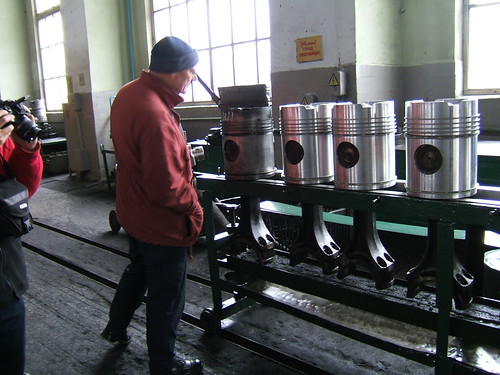 Piston/crank used on K6S310DR engine.
Piston/crank used on K6S310DR engine.
After our two fascinating visits to workshops, our coach struggled through the traffic again, to take us to our hotel on Independence Square. There was time for a little sightseeing later in the day and the following morning, before we were taken to the airport for our flights home.
Russian Railway background
At the time of my visit in 2005, I was almost completely ignorant about Russian Railway practice. The book 'Soviet Locomotive Types - The Union Legacy' (reference [1] below) is an invaluable primer on Russian steam, diesel and electric traction. In 2011, a river cruise from Moscow to St. Petersburg (described in a series of posts here) gave me tantalising glimpses of railways in Russia. Then, in 2011, I travelled by the 'Golden Eagle' private train from Ulaan Baatar to Moscow (described in a series of posts here).
Book References
[1] 'Soviet Locomotive Types - The Union Legacy' by A J Heywood & I D C Button (Frank Stenvalls Forlag) ISBN 0-9525202-0-6.
Photographs:
The railways:
Ukraine Steam.
Ukraine Modern Image.
Kiev Locomotive Works (Passenger).
Kiev Locomotive Works (Freight).
The country:
Ukraine.
